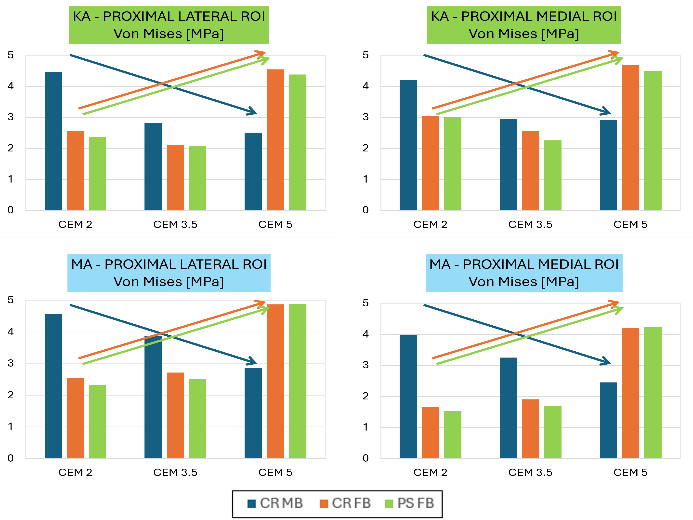German Congress of Orthopaedics and Traumatology (DKOU 2025)
Deutscher Kongress für Orthopädie und Unfallchirurgie 2025 (DKOU 2025)
Effect of design and fixation technique in TKA performance
2Università degli Studi di Firenze, Firenze, Italien
Text
Objectives and questions: Total Knee Arthroplasty (TKA) incidence is increasing exponentially year by year. The most used prosthetic designs for primary TKA are the Cruciate Retaining (CR) and Posterior Stabilized (PS) designs for both Press Fit (PF) and cemented implants – whether conventional (CEM) or hybrid (HY). Data indicates that fully cemented implants remain the most widely adopted choice by surgeons for TKA. Furthermore, Fixed Bearing (FB) designs are still preferred over Mobile Bearing (MB). It should be emphasized that a cemented implant (whether fully cemented or hybrid) can feature various cement thicknesses and literature rarely examines their effects on TKA performance. The goal of this finite element study is to examine how cement thickness, prosthetic design and alignment choice influence stress distribution in the bone and in the PMMA layer.
Material and methods: Finite element models were developed considering the geometry of a left composite tibia, medium size, with 3° varus alignment. A total of 42 models were analyzed. The materials and interactions were defined in accordance with literature. Four regions of interest (two proximal and two distal) were identified on the cortical bone, along with two regions on the cement layer. A load of 2 kN was applied along the mechanical axis. Concerning implant alignments, mechanical and kinematic alignment were considered. Regarding fixation techniques involving the use of PMMA, three thicknesses were considered: 2 mm, a conventional one of 3.5 mm, and 5 mm. All finite element simulations were conducted using Abaqus/Explicit version 2019 (Dassault Systèmes, Vélizy-Villacoublay, France).
Results: Distal regions appear to be significantly less affected by the prosthesis design and the cement thickness. In contrast, the proximal regions, particularly in the CEM configurations, show greater variability induced by differences in cement thickness. The M/L ratio was calculated for each configuration to analyze the effect of load distribution of the different alignment adopted. The results on PMMA show that hybrid configurations exhibit higher compressive stresses, while in cemented configurations, the mean stresses are higher and more significantly influenced by shear stresses.
Discussion and conclusions: No significant differences were observed between mechanical and kinematic alignment. Thickness of PMMA influences stress distribution, particularly in CEM configurations. In FB configurations, excessive use of PMMA can lead to higher stress on the cortical bone, associated with an increase in shear forces. In general, configurations with conventional thickness appear to provide the best results and ensure the greatest margin for error.
Figure 1 [Abb. 1]





